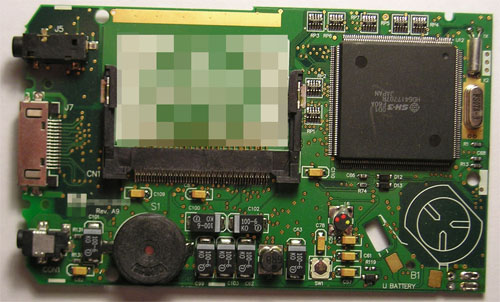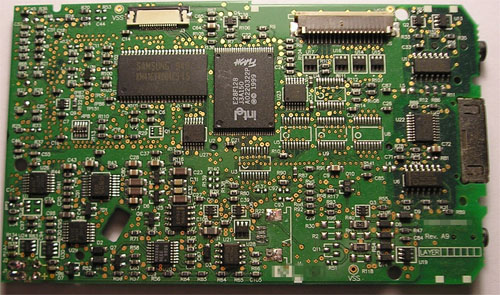The Ware for April 2008 is shown below. Click on the images for a larger version.
This ware is actually a reader-submitted ware, thanks to 92915810cf6b9f60b0bb06bc498ea884 for the ware! I love one-way hashes, don’t you? Protecting privacy while giving attribution…it’s great. The ware is actually a prototype of a device that was never made available on the market for sale, although when I poked around a bit I found enough documentation here and there on the web to make the contest solvable. The company that made these boards was clearly not shy about applying their logo liberally all over the board.
My apologies for the tardiness of the ware. This is one of the first times I’ve actually slipped well into the next month, but I hope to get back on track soon. Being at the Maker’s Faire in San Mateo earlier this month completely wiped out the weekend that I usually do the posting, and then I had a very busy couple of weeks.


Old Stuff. Date code on the flash is 1999. An SH-3 + Ram + Rom without a lot more. A buzzer, flat ribbon connectors and Compact Flash (?) connector. Could it be an ancient PDA : http://www.craigtech.co.uk/hpc/vendspec.html
There is a microphone jack, a charging outlet, probably a hot-syncing outlet, a CF card outlet, a SH-3 processor,16MB flash, a speaker, the two flex connectors are probably meant for LCD and maybe keypad.
Looks like an early day PDA to me. The Sh-3 processor is one of the chip use in early Win CE devices. During then, CF card is also more common, 16MB also seem like an early day specs.
My first thought was an HP Jornada, the SuperH 3 series chip was what made me first think of the 720 I loved so much.
Based on the size, I was thinking the 420 model, but the images I’m digging up of it don’t seem to show those two, what I assume are, TRS connectors.
Still searching.
On second thought, CON1 looks more like a DC supply.
I’ll say 6c97d42bda770de51b5d871904982af1 for now.
Hi, I’m “new” here! :) Technical specs are similar to the HP 360LX, but I don’t think this is a PDA in a “palmtop” form, because the connector for the display is in the same side as the CF slot opening, and I’ve never seen a palmtop with the CF opening in the back. Connectors position makes me also think about a more “classic” PDA look. Maybe this is not even a consumer PDA but an embedded industrial computer, because on the back there are no signs of a main battery connector (the back is the CF connector side, there’s also that nice Reset button). Or, maybe the battery connector is the desoldered one on the flash side? It’s near the power circuit…
Also, the CPU is running at 60mhz so the jornada 420 is not an option.
The Ericsson MC16 have similar specs also. Anyway, you said that this thing has never been sold to the public so…. I don’t know!
What a nifty device! I was not aware of it before, but contestants so far are very close. I’m taking myself out of the running due to a previous win, but I will give my hash for the answer: 37cfc04875e5b44639e801a28289a455
I took a look at pdadb (http://smartphonedb.com/index.php?m=pdamaster). Vendors who had manufactured pda using SH3 include HP, Casio, LG, Hitachi, and Ericsson. Since it has not been released, I would not be able to narrow down to the model, but have to agree with Mastro that specs of Ericsson MC-16 (though branded as Ericsson, pdadb indicates that it is actually manufactured by HP) is rather close.
Starting on the ‘back’
Intel E28F128J3A-150 StrataFlash memory, x8/x16 (128 Mbit), Vcc=3V, 150ns
Samsung km416v4004cs-L5 4M x 16bit CMOS dynamic RAM with extended data out, 3.3V power supply, 50ns, low power in 50-pin TSOP II package. Operational temperature range from 0°C to 70°C.
There are two ribbon connectors. Keyboard/Screen?
“Front”
SH-3 F60a HD6417707r – SuperH Hitachi Processor. http://www.icdevice.co.kr/korea/product_info/file/SH_FB.pdf 60MHz @ 3.3v.
CN1 Compact flash slot
J5 – Power?
CON1 – a dock of some sort.
J7 – head phone?
S1 – contrast wheel/Volume
SW1 – tactile push button switch. (Reset?)
Lower right corner appears that a battery pack was de-solderd here. B1/UBattery appears to be an internal battery location.
All of the large components make this appear to be old technology. And given the 1999 date on the intel flash that makes sense.
Looks like a 15 pin connector.
Some more searching came across: http://www.hplx.net/hardware.apa.big.html
The circuit board in this is very similar Even the white text where the CF port is!
Can not find a direct successor for HP. All of the HP’s do not have similar products that this would come from. (Speeds aere are 133 not 60mhz)
From the processor SH3 it could be from the following product lines.
Casio Cassiopeia
Compaq Aero
Ericsson MC1X
Hitachi ePlate
HP Jornada
LG Phenom
Palmax PDX
I can not seem to find one that is close enough to make a call on it. The only lead is the white writing and the HP matches in that.
Given that I will say it is some ‘economy’ version of an HP Jornada
I don’t know what this is but I’d bet the various logos are for Hewlett Packard. The shape of the blurred areas on the PCBs are a good fit for the various HP logos (either the small bracketed HP logo or the HP logo plus “Hewlett Packard” text).
The first thought that went through my head was also “Jornada” :) This device looks pretty small; extrapolating from the CF slot (how ungeeky, I should have extrapolated one of the chips) gives me roughly 4.5×3.1″.
Some googling later, I’ve come across a never-released prototype palm-sized device, with a SH3 processor, ROM, RAM, audio output, a side-mounted CF slot, a serial interface which seems to match J5, a reset pinhole for SW1 witch matches the relative alignment of the CF slot, an LCD (J3), a keypad (J6) and whose sha1sum is 4d1e6aae82644840a91a66dc5cfc7711566d931e.
(also New Here, hi everyone)
First time entry and my electronics is a bit rusty….
Unlike Mastro I go for a pda using keyboard + folding screen (a la psion) seen the placement and the existence of the 2 connectors on the back image. I never seen on a “palm style/no keyboard” pda that the headphone jack was on the same side as the docking connector/power supply, but I can be wrong of course. The
Battery operated seen the MAX846AC/D.
Not a Ericsson MC16 seen that has an PCMCIA and a CF slot.
Based on the spec’s I could find, a variant of the LG Phenom series or hitachi HPW-200EC that never was commercialized?
Hi David, I disagree with your component identification…
J5 – should be an audio jack connector
CON1 – is the power conector
CN1 – compact flash connector
J7 – Sync, proprietary, may or may not include charging (tracks are very thin)
S1 – Piezo speaker
polossatik, my ipaq 5450 has all connectors on the bottom! :) I’ve seen the desoldered pads near the backup battery, but they looked like an alternative soldering point for the backup battery, not the main one… But you’re right on the max846!
Jered and Alex, I’m curious to know how you managed to get there, I hope you’ll post what you searched for when the contest is over! ;)
Mastro Grippo: actually, given the physical size, I first thought it might be some old-school MP3 player of sorts. I also kept in mind that it’s a prototype. Since to me it “feels” like a Jornada (Li ‘coin’ cell for RAM backup power, for instance), I started out by assuming it’s a HP device.
If my discovery is correct however, it appears J5 is [ab]used for the serial interface, and with CON1 being the power connector, there’s no audio jack on this device. This supports the observations that the audio jack wouldn’t be on the same side as the docking/power connector.
Hey there,
Could it be from Hitachi or LG? Both, too, maybe? (both even made joint venture…)
Mh… So what’s J7 for? It seems connected on the other side to U22, that can be a level converter(like max232?) but I don’t see the typical caps for the voltage doubler near it… I still think that J5 is an audio jack, on the other side the circuit looks like an amplifier, with U13, U11 and Q2…. Anyway, I think it’s pretty clear who made this device… The ginormous logo is easily recognizable even if pixelated! ;)
I just stumbled across this site while looking for info on my HP 2600n printer.
Anyway, one look at that photo and I knew it had to be from an HP Xpander. The form factor of the board is obviously from a pocket pc device, the logo in the CF bar sure looks like it said HP, the specs match, etc. I’ve never seen one taken apart before, but from the outside it seems to match.
Heh, I suppose I should reveal:
$ echo -n “HP Xpander” | sha1sum
4d1e6aae82644840a91a66dc5cfc7711566d931e –
I don’t remember the exact sequence I used the first time, but apparently you can now google for “HP SH3 prototype player” and get a relevant second result (the first being this post :P).
Oh, well… Nice hit! ;) So what’s the big J7 connector for, if the 3.5mm jack is a serial connector? Is it possible to get the part # for U22?
J7 is probably the elusive “overhead projector” connector, but I can’t find any reference to the actual connection used — whether it may be standard vga or something else. It would make sense for U22 to be some video DAC; maybe we’ll be able to see the markings in the unobfuscated photos :)
None…
None…